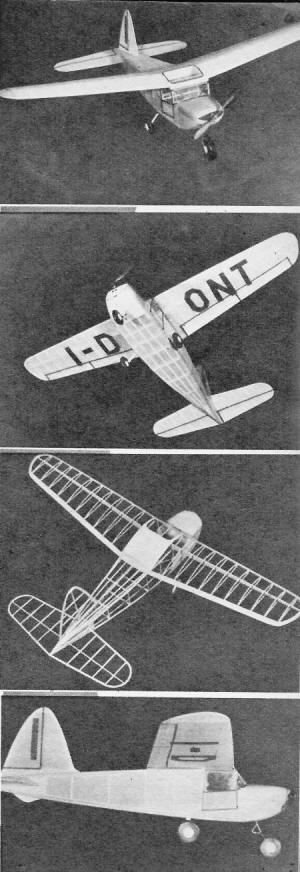|
The
Macchi MB−308 (or
MB.308), designed by Ermanno Bazzocchi, was one of the most popular light planes
in Italy in the 1940s. Although it appears to be of Cessna type construction
with an aluminum skin, in fact the MB−308 was of made entirely of wood - just
like this free flight model of it by Cristo Russo. With a wingspan of 24", it
is a medium size rubber-powered (or CO2) model built in stick and
tissue form. The tricycle landing gear was unusual in the era, and is not found
very often even in more contemporary free flight models. These plans and building
article appeared in the September 1949 issue of Air Trails magazine.
Macchi MB-308

A design to warm the heart of any builder of rubber-powered
flying scale models. This neat job also takes Campus A-100.
By Cristo Russo
Solid model builders can construct a same-size scale model right from these
plans. The flying model clan can obtain full size working drawings as part of
Air Trails Full Size Plan #949.
Italy's top offering to the lightplane enthusiast, the MB-308, bids fair
to become the favorite of all Europe. The wing is of a tapered cantilever design
coupled with a simple fuselage of neat, compact design seating two side-by-side.
Tricycle landing gear or twin floats may be used. It is sold with or without
a motor; the continental A-65 is the recommended power. The price is $3-5,000;
no accurate means of computing cost is available due to fluctuating European
currency. Span is 32' 9 1/2"; length overall 21' 3 1/2".
Ideally suited to a stable flying design, the MB-308 is presented here as
a small scale job for T-56 rubber or CO2 power. The model shown in
the photos uses a Campus A-100 motor. Construction is simple and light. Use
carefully selected balsa as specified.
 Build
two body sides on the plan side view. Assemble them as per top view and attach
bulkheads and stringers, using hard 1/16" sq. throughout. Trace the nose block
on soft balsa blocks; cut to outline shape; carve to contour; sand and give
several coats of clear dope, sanding between coats. Cut the blocks in half and
with a small gouge, hollow to the wall thickness shown. Cement together and
attach to nose of fuselage. Bend and insert wire landing gear. Wheels are of
balsa or celluloid. Small Trexler pneumatics may be used. Build
two body sides on the plan side view. Assemble them as per top view and attach
bulkheads and stringers, using hard 1/16" sq. throughout. Trace the nose block
on soft balsa blocks; cut to outline shape; carve to contour; sand and give
several coats of clear dope, sanding between coats. Cut the blocks in half and
with a small gouge, hollow to the wall thickness shown. Cement together and
attach to nose of fuselage. Bend and insert wire landing gear. Wheels are of
balsa or celluloid. Small Trexler pneumatics may be used.
Stabilizer and rudder are of conventional construction. Exercise, care to
prevent any warpage. Cover with Jap tissue and water-spray. Give one thin coat
of clear dope (use eight parts thinner to two parts dope).
Make a template from tin can metal of the largest rib (center). Proceed to
cut ribs of 1/16" sheet balsa. Make a cut along the top surface; move the template
down 1/16" and make another cut. Thus you have a rib 1/16" sq. Cut sufficient
ribs for top and bottom surfaces of the wing. Do not trim to proper length until
assembly. A pencil line drawn through each rib at the main spar position will
help when assembling the wing. Cut and prepare the leading edges, main spar
and trailing edges.
Pin them to the plan and cement the center ribs in place. Carefully cut to
length and cement the tip ribs in place. Attach the wing tips. This raises the
spars to the proper level so that the tops of the ribs can be cemented in place,
trimming off at leading and trailing edges for proper fit. Turn the wing structure
over and fit the bottom portion of the ribs in place.
Sight along the finished wing to check for good alignment, removing and replacing
any defective ribs. Join the wing panels to form the center section, using odd
bits of 1/16" sheet for gussets if desired. Cover the center section with light
1/32" sheet. Cut out the skylight and cover with thin celluloid or cellophane.
Cover the wing with Jap tissue, water-spray. and give one coat of light clear
dope.
Now, back to the fuselage. Install the desired power plant and' cover the
entire structure with Jap tissue. Water-spray and dope. Cut out window sections
and cover with thin celluloid. Cement the wing and tail surfaces in place; be
careful to line them up properly.
Decoration consisting of cabin and door outlines may be added. Cut them of
black tissue and dope in place. The "I" designates an airplane registered in
Italy. Some letter combinations seen on the MB 308 are I-DONT, I-FABR, I-RAIC
.and I-LAGA. However, it would not be improper to substitute U. S. private aircraft
license numbers.
Flight-testing is quite the same as for any simple model; balance the model
at the wing tips and add bits of modeling clay to nose or tail as required,
then easy glide test and last, power flight.
Our model balanced perfectly with the Campus A-100 and required only a slight
warp in the rudder for right circling flight. We fly it indoors to add variety
(and speed) to the usual slow flight of microfilm models. However. it is rugged
enough to be flown outdoors on a calm day.

Macchi MB-308 Plans, September 1949 Air Trails
Posted February 20, 2021
|